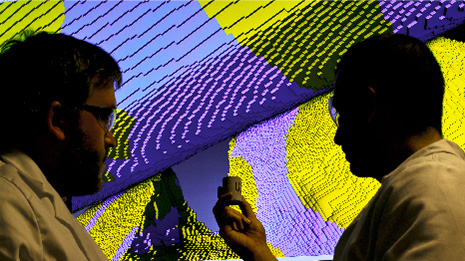




With digitalization, petrophysics testing
goes from months to weeks
Rocks can also have virtual doubles. Using very high resolution imaging, digital petrophysics reconstructs the properties of reservoir rock, cutting down decision time and reducing geological uncertainty in hydrocarbon exploration and production.
Scientists from the Repsol Technology Center have successfully concluded the Sherlock II project which combines data science, physics, and sophisticated numerical methods to create digital representations of subsoil rocks.
Scanning irregular rock fragments just a few millimeters big with x-ray tomography, the technology can create 3D models to run the tests done in a traditional petrophysics lab virtually.
Scientists want to discover properties like porosity, permeability, and the interaction between the rock and fluids within it to determine if a reservoir is profitable and what might be the best way to extract the oil or the gas.
This kind of digitalization can make it easier to analyze rock anywhere in the world so samples won't need to be brought to Madrid to be studied. This is especially appealing to Repsol since its activity has extended to new countries on five continents after incorporating Talisman.
Virtual petrophysics lab
Scientists at Repsol reconstruct the rock in 3D with great precision
Digital petrophysics, one of the seven key areas of technological knowledge that Repsol has decided to focus on in Exploration & Production, means "experiments that used to take three months can be done in three weeks," explains Carlos Santos, a scientist at the Repsol Technology Center and one of the leaders of the Sherlock II project.
Until now, to be able to analyze the properties of an exploratory well, a core had to be extracted from the subsoil, a cylinder of rock hundreds of meters long and with an approximate diameter of 10 centimeters, which is "a complex operation logistically speaking and that could in some cases up to triple a well's cost. But with this technology we don't need a core."
Just like when you're drilling a wall, during exploratory drilling in a well, rock fragments appear, and are scanned with a resolution "between a thousand and a million times higher than CAT scans used in medicine." This data is sent to the supercomputer at the Repsol Technology Center in Mostoloes, Madrid, where it is virtually analyzed with the software developed for Sherlock II.
With tomography, "what we're doing isn't an approximate model, it's an exact representation of the rock in 3D, up to the resolution allowed by the instruments. It's a digital double of the rock. If you printed it out on a 3D printer it would be basically the same object," says Santos.
Transforming stones into data also makes them easier to store than physical stones. Accumulated geological knowledge can last as long as the rocks themselves, because "there are already nanostructured quartz systems that allow you to save information for trillions of years.

Improve success rates
Self-financed research
with early application in Repsol projects
The best advantage is being able to reduce geological uncertainty in an industry where it is very high. "Up to now, if you were lucky, out of 20 wells maybe you got cores from two or three of them to analyze," but with Sherlock you can get the same information for all the wells and increase knowledge of a reservoir. This will improve Repsol's exploratory success rate, one that at 50% in 2015 was among the best in the industry.
The business investment in digital petrophysics has turned the Repsol Technology Center into a pioneer at the European level in this field. During its development, the research was tested with good results in Company pilots in South America and the Caribbean, saving up to 70% more in operating costs than other commercial technologies.
Its early application in the business has meant that the research project, with a price tag of almost eight million euros, paid for itself and that it is garnering recognition from international as well as Spanish institutions like CSIC (Spanish National Research Council). Digitalization also opens many doors in the gas and oil industry and tenders for new oil fields are even giving priority to companies with this technology.
Nanoscale for unconventional reservoirs
Unconventional reservoirs require nanometric rock analysis
Sherlock II also aims to improve knowledge of unconventional reservoirs or those with complex geologies where a substantial portion of unexplored resources reside. These kinds of reservoirs "have physical processes that are much more complex than traditional fields," such as rock types where the connections between their pores, key to understanding how to extract the oil or the gas contained within, are of nanometric scale (a nanometer equals one billionth of a meter).
Repsol scientists use ion beams to capture these nanoscale structures. Using an electron microscope, "ion beams and an electron scan allow us to take images dozens of nanometers thick," which are superimposed like slices of cheese until we build the 3D image.
The software developed for Sherlock II is based on the use of numerical methods, a branch of mathematics that translates the laws of physics into a numerical language, data the computer uses to translate the images into petrophysical properties. "It's impossible to simulate reality 100% but we're simulating it so much that the differences, from an industrial point of view, are irrelevant," concludes Santos.
 | |
| Download all the images in this News | |
 ZIP. 3,2 Mb ZIP. 3,2 Mb | |
 | |
| Download the complete articles in this News | |
 PDF. 2,8 Mb PDF. 2,8 Mb | |
Dirección de Comunicación |
Campus Repsol · C/ Méndez Álvaro, 44 |